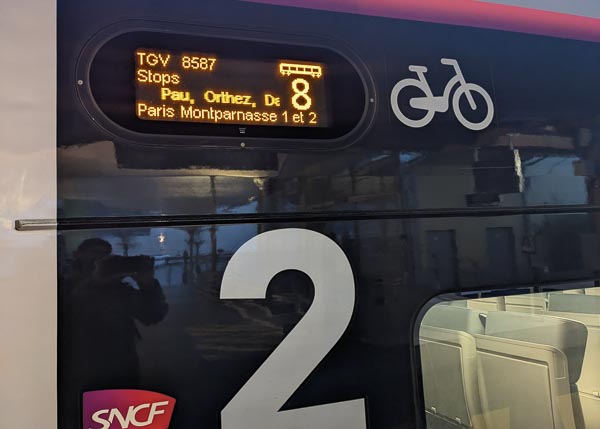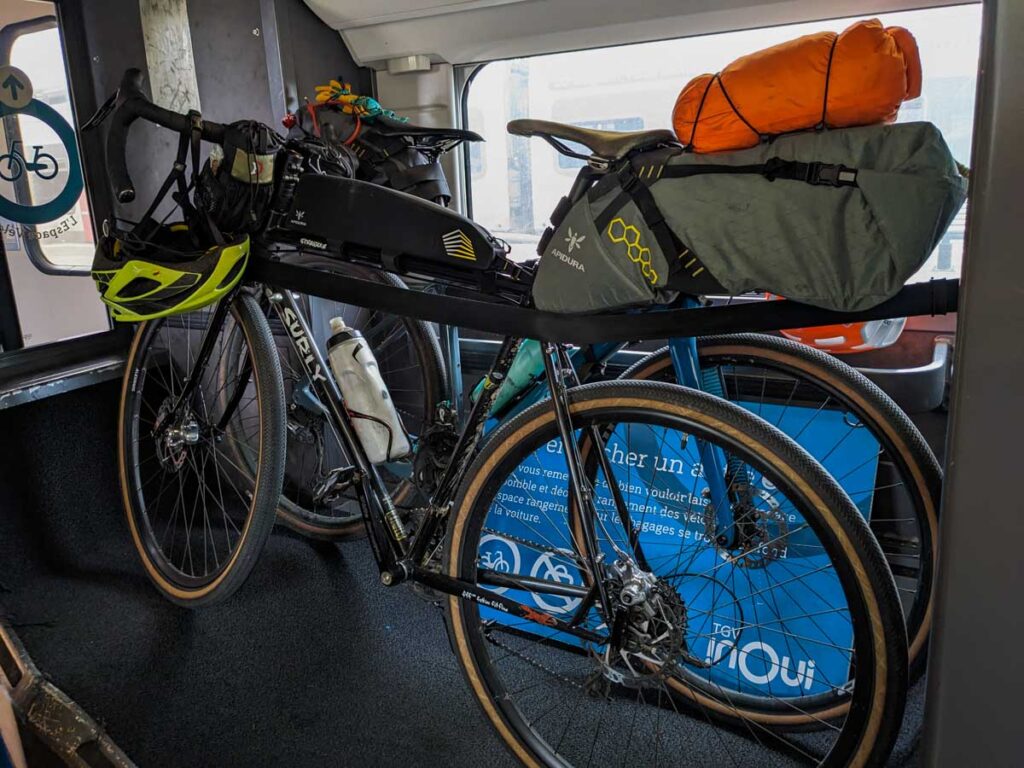Taking Bikes on French Trains: A bike rider’s Guide
If you have travelled to Europe before then you will know just how well connected the rail system is. As a form of travel, trains often offer up a more affordable and sometimes even quicker option than car or plane travel. So if you are exploring France by bike, then you will certainly want to know how to take your bike on French SNCF trains.
In 2018 we undertook our first bikepacking trip to France. This meant instead of hiring a car and driving from point to point, we made our way to each town by bike. Instead of suitcases filled with belongings, we had smaller bags strapped to our bikes, holding everything we would need for the next five weeks.
This wasn’t our first foray into bikepacking, we had done a couple of shorter trips back home in Australia. But this was taking it up a level. Whilst we planned to ride as much of our route as possible, travelling with our bikes on trains in order to get from one city to another was also our intention. This would allow us to traverse regions a lot quicker and easily stick to our broader holiday itinerary and see more of France.

The route we plotted would take us from the West coast of France, through the Cognac and Dordogne regions, with a loop to Bordeaux. We would then traverse across to the Pyrenees before eventually making our way to the French Alps and then over to Switzerland. We ended up catching two different types of trains on this trip – the fast TGVs and the slower TER regional train services. Preparing to travel with your bike on these two types of trains is vastly different.
A quick note before you proceed. We now have some updated articles about taking a bike on a train in France that you might like to have a look at. Since we first wrote this article we have taken our bikes on French trains many more times and have written a few other articles to help people who have not done it before.
Our How to Book a Bike on French Trains is a step-by-step guide on how to buy tickets and reserve a place for your bike. We update this if the booking process changes. Secondly, our Tips for Taking your Bike on French Trains article expands on the tips in this article as our experience has expanded. Finally, we have dedicated pages about Taking a Bike on a TER and Taking a Bike on a TGV train that goes into a little bit more detail about those services.
The information in this article is still valid and current and we do update the information when SNCF changes anything.
Taking bicycles on a TGV train in France
Our research into taking bikes on a TGV service identified that there were two options available. The first was to bring our bicycles as normal luggage. As long as our bicycles were in a case or cover that was no larger than 130cm x 90cm they could be brought on free of charge and stored in the luggage racks. The second option was bringing the bikes on and storing them in dedicated bike spaces on the train. This is not available on the route we planned to take so we prepared to take the bicycles on as normal luggage using the first option.
The next question we had was what were we going to use to put the bicycles in. As we were bikepacking we were planning to use cardboard bicycle boxes that would be put in the bin once we arrived in Paris. Our online enquiries led us to Japan of all places.
Rinko bags – what are they and how to use them for train travel
After some online research, we discovered Japan also has a similar requirement for bikes when taken on trains. They need to be dismantled and fully enclosed when taken onboard. The Japanese have designed a specific piece of equipment to assist cyclists with train travel. It is called a rinko bag. Pretty much it’s a very lightweight sack made of nylon. It ticked a lot of boxes. Given we were bikepacking we couldn’t have anything bulky, and when it wasn’t in use, it folded down to the size of a water bottle. It was also lightweight. With the benefit of watching a few YouTube clips we were sold on using them for our trip and ordered some from an online bike store in Japan.
So armed with our rinko bags, we packed our bikes and walked onto the platform. Of course, there were a few stressful moments as well. Train travel is popular and getting on and off train carriages holding a bulky dismantled bike isn’t necessarily the easiest of tasks. With the TGV trains, you are allocated a specific seat and carriage. Working out where the carriage stops on the platform is very important. This is because it really is first in best dressed when it comes to using the luggage racks. As it happened we were always able to find a place for our bikes – sometimes we just had to get a little inventive.
Can you take larger bicycle bags on TGV trains?
From Bordeaux, we were joined by another friend of ours who had their bicycle in a large Scicon soft bag. This bag is super convenient as you don’t need to detach the handlebars. In terms of packing your bike for travel, it doesn’t get much simpler. Unfortunately, the downside is this bag is also quite bulky. Ultimately making it outside the size limit of the French rail company.
Our friend got onboard and left their bicycle bag in the vestibule area next to the luggage rack. During the journey, the conductor called over the speakers asking that the person who owned the bicycle case contact them. They then spoke with our friend, letting them know the bag was too big to be travelling on the TGV. They stated that she would have to get off at the next station and should know that the case was too large. Our friend pleaded their case and was thankfully allowed to remain on the train – but it was at the discretion of the conductor. Definitely keep this in mind if you plan to use a larger bicycle bag on the TGV train.



Pre-booking bicycles as luggage on the TGV
If you have no other option than to use a larger bike bag, there is a provision on some TGV services to pre-book this as larger luggage. You will need to do this in advance when you book your tickets and your bikes will be loaded into a separate luggage area on a special carriage. We don’t have any experience of doing this ourselves.
Taking a bike on the French Regional TER trains
Travelling with a bike on TER trains in France is very convenient and also free. Unlike the TGVs, there is no requirement to pack the bike away. So no need to dismantle it or store it in its own self-contained bag. Instead, there are sections on the carriages which are designated for bike storage and you can bring your bike aboard fully assembled. Bicycle carriages are usually found at the front or end of the train in our experience. Each train is slightly different but in the main, you will generally find either vertical hanging hooks which hang your front wheel, or a dedicated area where you simply lean your bike.
Use the bike storage facilities on French trains
We had a situation where a train conductor was upset with us as we had stored our bikes incorrectly. Basically instead of using the hooks, we decided to just lean the bikes up against each other. This was so we wouldn’t need to take off our bikepacking bags. When the conductor saw our bikes like this we were instructed to place them in the hooks for safety reasons. We quickly took the bags off and stored the bikes from the designated hanging hooks. To be honest, the hanging hooks are far more secure and we should have done this in the first place. Lesson learned – when there are set storage facilities for bikes put in place, use them.
How to travel with your bike on other French train networks
When we first wrote this article in 2020 we had only taken our bikes on the TGV as luggage and the TER services. As of 2023, we have now taken our bikes on the TGV train as luggage and as assembled bikes, on Intercité trains, on TER services and finally as luggage on the Night trains. The other articles about trains in France we outlined above provide more information about all the services and our experience.

SNCF, the French rail company
SNCF is the French rail company and we did most of our research on the SNCF Connect website which is also where you can book your ticket. For travel on the TGV and Intercité trains, you can book a ticket 90 days in advance while you can book a ticket on a TER service 120 days in advance.
We also have the SNCF app on our mobile phones. It allows us to book a ticket on the go and have the ticket loaded onto the app for scanning on the train.
If you are planning a trip to France in 2023 and including train travel in your itinerary we want to draw your attention to strikes by SNCF workers disrupting services. Strike action over pension reform has periodically disrupted train services since January 2023. There is no knowing how this will progress further into 2023 but we recommend keeping an eye on the SNCF website for any information about possible future strikes if you are planning to book a ticket. Once strike action is announced the SNCF booking page shows a warning so you can make alternative arrangements.
Summing up – Taking your bike on French trains
Whilst travelling with a bicycle on the French trains can sometimes throw up its own stresses, we found it to be very worthwhile. It was a much cheaper and often quicker way to travel. It also made navigating the larger cities a lot easier too, as you didn’t need to ride your way through any city traffic when using trains to get from point A to point B.
One thing we will do differently next time we are in France is to restrict any train travel to the TER trains. Whilst they don’t travel at the same speeds as the faster TGVs, they are a lot easier to navigate with a bicycle. Not needing to disassemble the bicycle before taking it on board is also a huge plus. Another plus is there are no extra fees to pay to take your bicycle with you on this network.
We hope you can learn from our experiences of travelling with bicycles on French Trains. All in all, we found it a really great way of covering longer distances and exploring more of the country too.
8 TIPS & TRICKS for taking a bike on French trains on your cycling holiday
1. Research any restrictions prior to purchasing your train tickets. Be aware these are different for each network. You want to know well in advance whether you need to disassemble your bike or not prior to arriving on the platform.
2. The French Regional trains – TER – are the easiest and cheapest train network to navigate with a bike. While the trip might be slower it is definitely the most convenient.
3. Consider using a rinko bag for a lightweight and handy solution to help with bike travel on the TGV trains.
4. If you are disassembling your bike for train travel, seek out an empty train platform if possible. We found the end of the platform is generally quieter and provides a good space to work with.
5. Avoid travelling during peak commuter times. (In some cities you will not be able to take a bike with you during these times).
6. A bike symbol on the outside of a train carriage denotes that the carriage has space for bicycles.
7. Make sure to validate your ticket prior to boarding if you have a paper ticket
8. Be nice when dealing with train conductors. It can sometimes be at their discretion whether you are allowed to travel with your bike. A smile and a ‘merci beaucoup’ can go a long way.
